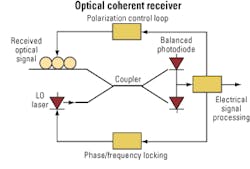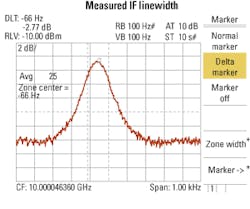Nonetheless, the pace to bring down the cost per bit/sec/km has further accelerated in the post-bubble era. To cost-effectively expand the reach and data capacity of existing fiber plants, several technical challenges need to be tackled, including increasing robustness versus noise and transmission impairments, and achieving high spectral efficiency. The use of modulation techniques such as differential phase-shift keying (DPSK) as well as adaptive electrical equalization is being considered to achieve these goals.
To further extend capacity and repeaterless transmission distances, one has to go beyond the currently used direct-detection scheme and make use of optical coherent detection. Instead of detecting only the amplitude of the optical signal, coherent detection can detect amplitude, phase, and polarization of the optical signal. This will enable transmission of more data within the same optical bandwidth. Moreover, in a coherent system, the preservation of the optical phase can be used to cost-effectively compensate optical transmission impairments in the electrical domain.
The basic coherent receiver structure is shown in Figure 1, where the received optical signal is mixed with the light of an optical local oscillator (LO). In this way, the signal is down converted from the optical carrier frequency (~200 THz at 1.55 µm) to a microwave carrier frequency (of a few gigahertz). The resulting beat signal after photo detection exhibits a center frequency that corresponds to the intermediate frequency ƒIF (IF), which is the difference between the signal frequency and the LO frequency.
If the signal frequency and the LO frequency are the same, the detection technique is called “homodyne.” For different center frequencies of signal and LO, the system is referred to as “heterodyne,” with ƒIF = ƒc - ƒLO, where ƒc and ƒLO are the center frequencies of the received signal and LO, respectively. For heterodyne systems, the IF has to be at least two times the data rate to receive the double-sided data spectrum. Homodyne reception requires that the LO laser be phase-locked to the incoming optical signal, whereas heterodyne detection calls for frequency locking to the received signal.
The main building blocks of the coherent receiver are an optical LO, optical coupler, balanced photodetector, phase/frequency locking, polarization control loop, and electrical signal processing. Within these blocks, there are several requirements necessary to achieve high receiver sensitivity1:
1. A high-power, optical LO with low relative intensity noise (RIN) and low laser linewidth.
2. A balanced photodetector with high responsivity, high optical-power-handling capacity, and good common-mode rejection ratio (CMRR).2
3. Phase/frequency locking to reduce the phase and frequency noise of the IF.
Coherent receivers offer several advantages that improve optical network performance. These advantages include an increase in the data capacity of existing fiber links, the ability to accommodate multiple modulation formats, superior receiver sensitivity, and the compensation of optical signal impairments in the electrical domain.
For example, it has been shown that multilevel modulation formats such as differential quadrature phase-shift keying (DQPSK) can be used to increase the data capacity of existing fiber-optic links. This is achieved by transmitting more data within the same optical bandwidth compared to conventional OOK.As Wree, et al., have reported, two independent DQPSK signals each at a different optical polarization (polarization multiplexing) can be combined to transmit 40 Gbits/sec within the bandwidth that would be occupied by only 10 Gbits/sec using OOK.3 This enables quadruple the data throughput for a given optical amplifier bandwidth. The signal is demodulated with a delayed replica of itself using four Mach-Zehnder delay interferometers, each incorporating a control loop.
This receiver, however, has a higher complexity compared to a coherent receiver, and the maximum transmission distance is limited to a few hundred kilometers, mainly due to distortions arising from polarization-mode mixing. In the case of coherent detection, the phase and polarization of the signal can be detected much more efficiently, and optical distortions can be effectively compensated by an electrical equalizer to enable long transmission distances. It is also possible to omit dispersion-compensating fiber and optical amplifiers at the receiver.
Another plus for coherent receivers is the ability to handle multiple modulation formats. Currently, optical transponder companies are investigating such modulation formats as DPSK, DQPSK, and duobinary. As these formats are applied, optical networks very likely will have to accommodate several modulation schemes at the same time. Receivers based on coherent detection offer this ability; adaptation to different modulation formats occurs with minimal changes using electrical signal-processing techniques instead of using optical devices to demodulate the signals.3
For phase-shift keying, it is especially important that the phase-locked loop (PLL) reduces the frequency and phase noise of the received signal. With current DFB laser technology and optimized electronic design of the PLL, the IF linewidth (normally several megahertz) can be reduced by four orders of magnitude to values as low as 100 Hz (see Figure 2).4
Additionally, by mixing the signal with the LO, the received optical signal can be amplified without noise penalty provided that there is no RIN of the LO laser. Compared to simple direct detection without optical preamplification, the sensitivity can be improved by up to 20 dB using coherent detection. Due to this increased receiver sensitivity, coherent detection was considered intensively before the advent of the EDFA in the 1980s and 1990s. The table illustrates that even in presence of such optical amplifiers, coherent detection can still provide superior receiver sensitivity over direct detection.5The table shows the theoretical receiver sensitivities for a bit-error ratio of 1×10-9 in photons/bit for direct detection and coherent detection if amplified spontaneous emission (ASE) of the EDFA is the dominant noise source. The improvement in the required optical signal-to-noise ratio (OSNR) is also given. The results are experimentally confirmed and shown in Figure 3.4 Note that in the case that a narrowband optical ASE filter is used after the optical preamplifier, there is no difference in the required OSNR between heterodyne and homodyne detection.
Finally, in terms of dealing with signal impairments, coherent detection enables the use of adaptive electrical equalizers to compensate for optical transmission impairments in the electrical domain at lower cost versus compensation in the optical domain.6 In direct detection, only intensity is measured and optical phase information is lost. The nonlinear transformation of the optical signal into the electrical domain further complicates the process of electrical equalization.
In contrast, coherent detection transforms the optical signal linearly into the electrical domain and preserves the phase information. For example, distortions arising from chromatic dispersion and polarization mode dispersion (PMD) can be completely mitigated electrically with simple digital signal-processing techniques such as a tapped-delay line filter. D.E. Crivelli, et al., have shown that 40 Gbits/sec (comprising two polarization-multiplexed DQPSK signals) can be transmitted over 300 km of standard singlemode fiber with significant PMD (10 psec/(km)-1) using a tapped-delay line filter (15 taps) to electrically equalize the signal.7 Meanwhile, A.H. Gnauck, et al., have shown that a passive element built of a microstrip line can compensate for 220 km of standard singlemode fiber.8 Such performance can significantly reduce the need for dispersion-compensating fiber and PMD compensators.
To exploit the potential advantages of coherent receivers for the telecom industry, the technology must be integrated within a small footprint and offer low power consumption at a compatible price compared to direct detection. The trend toward high-level integration of optical coherent receivers has already begun by combining the optical LO, PLL, coupler, balanced photodetector, and electronic signal processor with the corresponding control and bias circuits into a coherent optical front end.1
Once implemented, coherent receiver systems will reduce capital expenditures (capex) for system providers in several ways:
1. They can quadruple data capacity over existing fiber links by effectively detecting multilevel modulation (using optical phase and polarization information).
2. They will use effective electronic compensation instead of optical compensation (mainly, equalization of chromatic dispersion and PMD).
3. They will increase reach and lower the number of OEO terminals due to superior receiver sensitivity (and thus lower required OSNR), especially when combined with phase-shift keying techniques.
4. They will enable upgraded WDM systems that can handle different modulation formats via one receiver platform.Meanwhile, savings in operational expenditures (opex) can be obtained via lower required OSNR, which will allow more system margin with less maintenance in the field (e.g., less connector cleaning). Also, coherent receivers will enable rerouting of signals with fewer optical link reconfigurations by using adaptive equalization techniques that are implemented effectively in the electrical domain with no loss of optical phase information.
Optical coherent receivers combined with advanced modulation formats and electronic signal processing will increase the data capacity and reach of existing fiber-optic links. Savings in capex and opex will mainly arise from greatly increasing the spectral efficiency, allowing rigorous electrical compensation of optical impairments and more flexible network design.Christoph Wree is coherent systems engineer, Abhay Joshi is president, and Don Becker is coherent systems program manager at Discovery Semiconductors Inc. (Ewing, NJ; www.chipsat.com).
References
1. D. Becker, C. Wree, D. Mohr, and A. Joshi, “Optical Coherent Receivers for 2.5 and 10 Gbits/sec,” Proceedings of the IEEE Avionics Fiber-Optics and Photonics Conference, Minneapolis, MN, September 20-22, 2005, pp. 33-34.
2. A. Joshi, X. Wang, D. Mohr, D. Becker, and C. Wree, “Balanced photoreceivers for analog and digital fiber-optic communications,” Proceedings of SPIE, vol. 5814, 2005, pp. 39-50.
3. C. Wree, N. Hecker-Denschlag, E. Gottwald, P. Krummrich, J. Leibrich, E.-D. Schmidt, B. Lankl, and W. Rosenkranz, “High Spectral Efficiency 1.6-bit/sec/Hz Transmission (8x40 Gbits/sec with a 25-GHz Grid) over 200 km SSMF Using RZ-DQPSK and Polarization Multiplexing,” Photonics Technology Letters, vol. 15, no. 9, September 2003, pp. 1303-1305.
4. Private Communications, Dan Mohr, senior engineer, Discovery Semiconductors, 2005.
5. J.M. Kahn and K.-P. Ho, “Spectral Efficiency Limits and Modulation/Detection Techniques for DWDM Systems,” IEEE Journal of Selected Topics in Quantum Electronics, vol. 10, no. 2, January/April 2004, pp. 259-272.
6. A. Faerbert, S. Langenbach, N. Stojanovic, C. Dorschky, T. Kupfer, C. Schulien, J.-P. Elbers, H. Wernz, H. Griesser, and C. Glingener, “Performance of a 10.7-Gbit/sec Receiver with Digital Equaliser using Maximum Likelihood Sequence Estimation,” Proceedings of the European Conference on Optical Communication (ECOC), Stockholm, Sweden, September 5-9, 2004, post-deadline paper PD-Th4.1.5.
7. D.E. Crivelli, H.S. Carrer, and M.R. Hueda, “Adaptive Digital Equalization in the Presence of Chromatic Dispersion, PMD, and Phase Noise in Coherent Fiber-Optic Systems,” Proceedings of the IEEE Global Communications Conference (GLOBECOM), Dallas, TX, November 29-December 3, 2004, vol. 4, pp. 2545-2551.
8. A.H. Gnauck, J. Sinsky, P.J. Winzer, and S. Chandrasekhar, “Linear Microwave-Domain Dispersion Compensation of 10-Gbit/sec Signals using Heterodyne Detection,” Proceedings of the Optical Fiber Communications Conference (OFC), Anaheim, CA, January 5-10, 2005, post-deadline paper PDP31.



